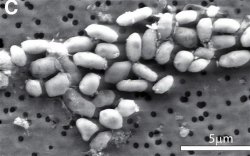 NASA scientists have found a creature that can live where no creature has lived before in a discovery that raises the chances of alien life evolving on other planets.
NASA scientists have found a creature that can live where no creature has lived before in a discovery that raises the chances of alien life evolving on other planets. NASA scientists have found a creature that can live where no creature has lived before in a discovery that raises the chances of alien life evolving on other planets.
NASA scientists have found a creature that can live where no creature has lived before in a discovery that raises the chances of alien life evolving on other planets.
The bugs, described as a form of "weird life" by scientists, are able to thrive on arsenic — and even incorporate it into their DNA.
Arsenic is one of the most deadly substances known to most organisms. It usually disrupts metabolic pathways, making it impossible for the normal mechanisms of life to continue.
But the strange microbes scooped from mud at the bottom of a Californian lake not only survive in an arsenic environment but make the chemical part of their molecular structure.
The discovery is said to have huge implications for the search for extraterrestrial life because it suggests that life is even more adaptable than previously thought and could even survive on hostile planets.
Dr Felisa Wolfe-Simon, from Arizona State University, who led the US researchers, said: "Our findings are a reminder that life as we know it could be much more flexible than we generally assume or imagine.
"If something here on Earth can do something so unexpected, what else can life do that we haven't seen yet? Now is the time to find out."
When scientists talk about life they tend to mean "life as we know it" – that is, life based on the biological building blocks found on Earth.
But some experts have speculated that there may be alternative kinds of life – dubbed "weird life" – elsewhere in the universe.
The new find lends support to that theory, increasing the prospects of discovering life on Mars or the moons of Saturn or Jupiter, or outside the Solar System.
All "known" life requires six fundamental elements – carbon, hydrogen, nitrogen, oxygen, phosphorous and sulphur – which provide the building materials for DNA, proteins and fats.
Phosphorous, normally obtained from inorganic phosphate, is a key member of this group and found in many of the components of cells.
Without it, life should not be able to exist.
But the bugs studied by Dr Wolfe-Simon's team have the extraordinary ability to swap phosphorous for arsenic.
The microbes were grown in laboratory dishes in which phosphate salt was gradually replaced by the toxic element.
In the end, the bacteria were able to grow without any phosphorous at all.
Using radioactive tracers, the scientists tracked the arsenic as it became part of the bugs' essential biochemical machinery, including proteins, cell membranes and DNA.
Professor Ariel Anbar, an astrobiologist from Arizona State University, who co-authored the study reported in the journal Science, said: "Life as we know it requires particular chemical elements and excludes others.
"But are those the only options? How different could life be? One of the guiding principles in the search for life on other planets, and of our astrobiology programme, is that we should 'follow the elements'.
"Felisa's study teaches us that we ought to think harder about which elements to follow."
The bacteria belong to a particular strain of the Halomonadaceae family called GFAJ-1.
Their home at the bottom of Mono Lake, near California's Yosemite National Park, is super-salty with naturally high levels of arsenic.
It is an environment that should be extremely hostile to life, but the Halomonadaceae bacteria thrive there.
Scientists found that the organisms had a "dual capability" when it came to staying alive.
On the one hand they were able to live like normal life-forms, using phosphorous in their molecules. But when necessary the strain could switch to a "weird" mode of life that relied on arsenic.
Professor Paul Davies, also from Arizona State University, said: "That makes it very peculiar, though it falls short of being some form of truly 'alien' life belonging to a different tree of life with a separate origin. However, GFAJ-1 may be a pointer to even weirder organisms. The holy grail would be a microbe that contained no phosphorus at all."
In some ways it made sense that an organism should choose arsenic as a substitute for phosphorous, said Prof Anbar.
The element is toxic because its chemical behaviour is so similar to that of phosphorous, allowing it to "clog up" the works of biochemical machinery.
Professor Colin Pillinger, who led the Beagle 2 Mars landing mission, said it was interesting development and proved that life is very adaptable.
"It suggests that there could be smaller organisms living in similar areas that they have adapted to through evolution."